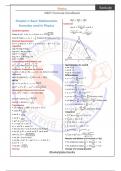Summary
Summary Phy Formula Handbook Class 11
- Course
- Institution
If you struggle with remembering formulas of physics and want to elevate the game, this Formula Handbook is for you. Now it will be a child's play to learn all the formulas as this study guide will help you!
[Show more]



